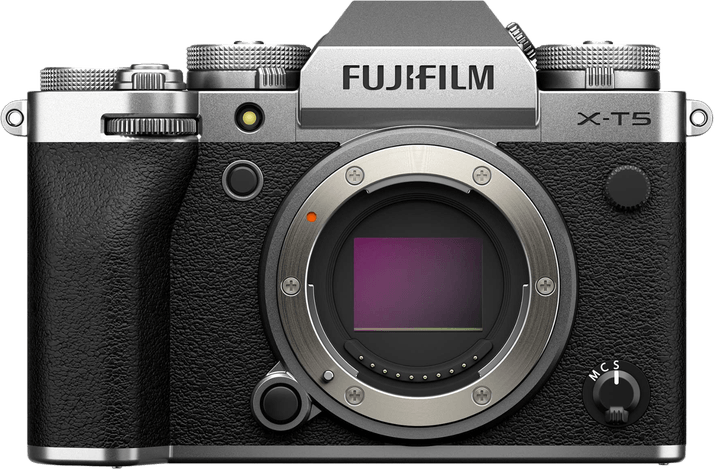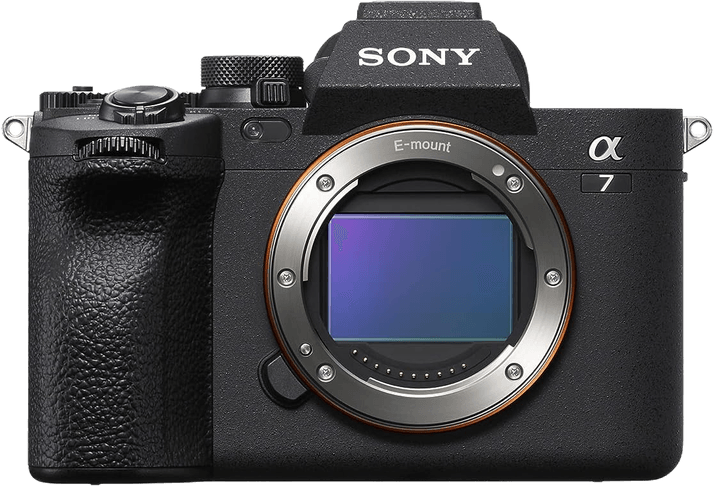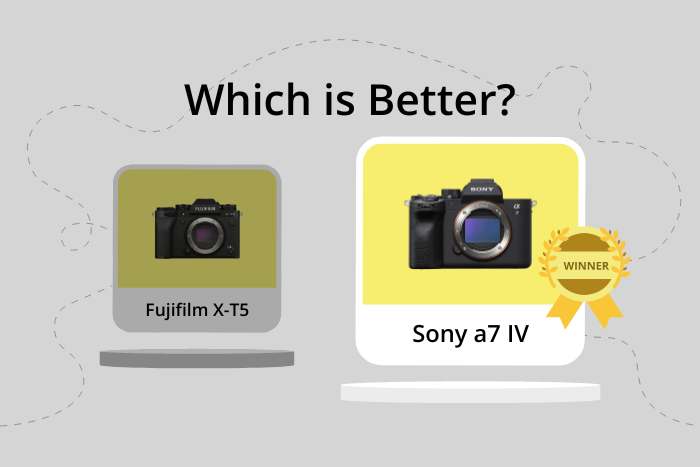Fujifilm X-T5 vs Sony a7 IV Comparison
Fujifilm X-T5

Sony a7 IV

The Sony a7 IV outperforms the Fujifilm X-T5 with a score of 84/100 compared to 81/100. Both cameras are mirrorless and were released recently, with the X-T5 in 2022 and the a7 IV in 2021. They share similar dimensions, but the X-T5 is lighter at 557g, compared to the a7 IV at 659g.
The Sony a7 IV’s higher score highlights its overall superior performance. However, the Fujifilm X-T5 has its advantages, such as its lighter weight and lower launch price.
Considering the scores and specifications, the Sony a7 IV stands out as the better camera, but the Fujifilm X-T5 offers a more affordable and lightweight option for photographers. So, Fujifilm vs Sony? Let’s dive in!
Fujifilm X-T5 vs Sony a7 IV Overview and Optics
The Sony a7 IV triumphs over the Fujifilm X-T5 in our optics comparison with a score of 85, compared to the X-T5’s 81. Both cameras share several key specifications, including CMOS sensor type, image stabilisation, and lens mounts specific to their respective brands. However, notable differences exist in other areas, resulting in the Sony a7 IV’s higher score.
The Sony a7 IV’s advantages include a full-frame sensor, compared to the Fujifilm X-T5’s APS-C sensor. This larger sensor size contributes to better overall image quality and improved low-light performance. Furthermore, the Sony a7 IV features a Bionz XR processor, which facilitates faster image processing and enhances overall performance.
On the other hand, the Fujifilm X-T5 boasts 40 megapixels, compared to the Sony a7 IV’s 33 megapixels. This higher resolution allows for more detailed images and greater flexibility in post-processing. The X-T5 also has a faster shooting speed of 15 frames per second, compared to the a7 IV’s 10 frames per second, making it better suited for action photography or capturing fast-moving subjects.
Despite these advantages for the Fujifilm X-T5, the Sony a7 IV’s full-frame sensor, high DXOMARK score, and superior processor lead to an overall better performance in optics. The Fujifilm X-T5’s higher megapixel count and faster shooting speed may appeal to some photographers, but the Sony a7 IV ultimately offers a more compelling package in terms of image quality and performance.
Fujifilm X-T5 vs Sony a7 IV Video Performance
The Sony a7 IV outperforms the Fujifilm X-T5 in video capabilities with a score of 91, compared to the Fujifilm’s 87. Both cameras share common features such as time-lapse functionality built-in, which is a useful tool for creating dynamic videos in various settings.
The Sony a7 IV’s superior video performance is evident in its higher frame rate, allowing for smoother slow-motion footage at 120fps, double the Fujifilm X-T5’s 60fps. This higher frame rate is beneficial for capturing fast-paced action or adding a cinematic touch to videos. Although the Fujifilm X-T5 has a higher maximum video resolution at 6K (6240×4160), the Sony a7 IV’s 4K (3840×2160) resolution is still more than sufficient for most videography needs and is widely accepted as the industry standard.
On the other hand, the Fujifilm X-T5’s 6K video resolution provides a higher level of detail and clarity, which might be advantageous for those seeking to produce exceptional video quality. However, this advantage might not be as significant for the average user, considering the widespread use of 4K resolution.
Based on these points, the Sony a7 IV proves to be a more versatile and reliable option for videography, with its higher frame rate and industry-standard 4K resolution. We recently named it our best Sony camera for video. The Fujifilm X-T5, while offering a higher video resolution, may not provide a substantial benefit to most users. Therefore, the Sony a7 IV is the better choice for those prioritizing video performance in their camera selection.
Fujifilm X-T5 vs Sony a7 IV Features and Benefits
The Fujifilm X-T5 wins in the features category with a score of 85, while the Sony a7 IV scores 83. Both cameras share many common specifications, such as a 3-inch screen size, touchscreen functionality, flip screen, GPS absence, and connectivity features like WIFI and Bluetooth.
The Fujifilm X-T5 outperforms the Sony a7 IV with its higher screen resolution of 1,840,000 dots, compared to the Sony’s 1,040,000 dots. This difference results in a sharper and clearer display on the X-T5, enhancing the user’s experience when reviewing images or navigating the menu.
On the other hand, the Sony a7 IV still has its merits despite its lower feature score. The a7 IV matches the X-T5 in terms of screen size, touchscreen, flip screen, and connectivity options, ensuring a competitive and modern user experience. However, there are no specific areas where the Sony a7 IV outperforms the Fujifilm X-T5 in the features category.
To summarize, the Fujifilm X-T5 takes the lead in the features category due to its superior screen resolution, offering users a better visual experience. We recently gave the X-T5 the top spot in our post on the best cameras for nature photography. The Sony a7 IV remains a strong contender with its similar specifications but falls short in the screen resolution aspect. Ultimately, users seeking a camera with better display quality should opt for the Fujifilm X-T5, while those who prioritize other factors may still consider the Sony a7 IV as a viable option.
Fujifilm X-T5 vs Sony a7 IV Storage and Battery
The Fujifilm X-T5 and the Sony a7 IV have identical storage and battery scores of 76. Both cameras offer two memory card slots, providing ample storage for photographers. The X-T5 accepts SD, SDHC, and SDXC cards (UHS-I compatible), while the a7 IV is compatible with CFexpress Type A and SD cards (UHS-II compatible).
In terms of battery life, both cameras deliver 580 shots per charge. The Fujifilm X-T5 uses an NP-W235 battery, and the Sony a7 IV uses an NP-FZ100 battery. Additionally, both cameras have USB charging capabilities for added convenience.
Despite their equal scores, the Sony a7 IV has an advantage in its compatibility with faster UHS-II memory cards and CFexpress Type A cards, which can provide quicker data transfer rates. However, the Fujifilm X-T5’s UHS-I compatibility may be sufficient for many users and is generally more affordable.
Fujifilm X-T5 vs Sony a7 IV Alternatives
Still not certain which model to choose? If you want to check out some more specs for inspiration, why not start with these related comparisons:

